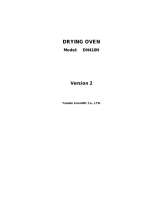
Contents
1 Getting to know your Moisture Analyzer ...................................................................................... 6
1.1 Introduction ................................................................................................................................ 6
1.2 What is the Halogen Moisture Analyzer used for ............................................................................. 6
1.3 Safety has priority ...................................................................................................................... 7
1.4 Important information about these instructions ............................................................................... 9
1.5 Disposal .................................................................................................................................... 9
1.6 Finding More Information ............................................................................................................. 9
2 Your first measurement in next to no time ................................................................................. 10
2.1 Unpacking and checking the standard equipment ......................................................................... 10
2.2 Selecting the location ................................................................................................................. 11
2.3 Setting up, leveling and connecting to power supply...................................................................... 11
2.4 Your first measurement .............................................................................................................. 13
3 How to obtain the best results .................................................................................................. 17
3.1 Measurement principle of the Halogen Moisture Analyzer ............................................................... 17
3.2 Notes on adjustment of the balance and the heating module .......................................................... 18
3.3 Optimum sample preparation ..................................................................................................... 19
4 Practical application of your Moisture Analyzer ......................................................................... 20
4.1 The operating concept and methods ............................................................................................ 20
4.2 The menu ................................................................................................................................. 21
4.3 Choosing and allocating methods from database ......................................................................... 21
4.4 Developing own methods and defining parameters ....................................................................... 23
4.4.1 Specifying name of method ........................................................................................................ 23
4.4.2 Specifying target weight of sample .............................................................................................. 24
4.4.3 Selecting the drying program ...................................................................................................... 25
4.4.4 Setting the drying temperature ..................................................................................................... 25
4.4.4.1 Setting the drying temperature directly .......................................................................................... 26
4.4.5 Temperature reduction ............................................................................................................... 26
4.4.6 Selecting the switch-off criterion .................................................................................................. 27
4.4.7 Setting time interval for free switch-off criterion .............................................................................. 29
4.4.8 Setting drying time for timed switch-off ........................................................................................ 29
4.4.9 Selecting the display mode ......................................................................................................... 29
4.4.10 Activating free factor .................................................................................................................. 31
4.4.11 Specifying free factor ................................................................................................................. 31
4.4.12 Choosing number of decimal places ........................................................................................... 32
4.4.13 Saving new method and exiting menu ......................................................................................... 32
4.4.14 Printing out records of methods .................................................................................................. 33
4.5 Performing a measurement ........................................................................................................ 33
4.6 Information on the measurement record ....................................................................................... 37
5 Basic settings of the instrument ................................................................................................ 38
5.1 Menu overview ......................................................................................................................... 38
5.2 Testing the moisture analyzer with SmartCal ................................................................................. 39
5.3 Adjusting the balance ................................................................................................................ 41
5.4 Adjusting the heating module ..................................................................................................... 43






















